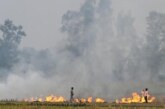
Dr. Arvind Kumar

The climate emergency continues to challenge existing norms and ways of working. The recent IPCC reports and the Global Assessment Report made it clear that climate impacts will further intensify, requiring us to transcend beyond conventional institutional silos and recalibrate governance beyond the current confines of climate change adaptation (CCA) and disaster risk reduction (DRR). To be ahead of growing climate and disaster risks, we need to ensure interoperability of interventions, integration of DRR and CCA, risk informed and climate smart development, we also need to build resilience and improve policy coherence on DRR & CCA, improve knowledge in nature based solutions and connect people, initiatives, and approaches at the global, national, and sub national levels.
The United Nations Office for Disaster Risk Reduction recently released a report on the impacts of hazards, disasters, and anthropogenic climate change. The report agrees that, indeed, many achievements of Sustainable Development Goals have been sidelined by the severe and complex impacts of the risks that humanity faces today. The contemporary global risk Scape is characterized by high stakes and significant uncertainties: from the critical degradation of the environment and ecosystem services, to social and economic recessions, the increasing severity of, and mortality from, weather extremes and other environmental hazards, and the interconnecting and interacting health and social maladies, among others.
The global empirical evidence shows that many disaster risk reduction and management (DRRM) interventions and policies have been plagued with top-down approaches and highly technocratic and exclusive measures that, instead of delivering just outcomes, have only marginalized some segments of the population, especially the vulnerable. Despite their developmental objectives, DRRM policies and interventions have unintended impacts and consequences that we should vigilantly review and learn from.

South Asia is identified as one of the most vulnerable India is one of the most disaster-prone countries in the world. Hazards continue to strain not only the country’s economy, but the wellbeing and happiness of its people. It is exposed to recurrent natural hazards such as floods, cyclones, earthquakes, landslides, and droughts. Anthropogenic hazards from chemical, biological and nuclear threats are also a concern given the high population densities and rate of industrial development. The situation has worsened due to climate change, attrition of biodiversity, and degradation of the environment. More than 1,098 lives have been lost this year (till July 17) due to natural calamities, including landslides, flash floods, and cloudbursts, Lok Sabha data reportedly revealed. As many as 1,593 lives were lost due to natural calamities in 2021-22; 1,989 in 2019-20 and 2,422 in 2020-21. Many of these lives could have been saved if there was an alert. Therefore the need to strengthen the National Disaster Management Authority has assumed urgency.
Furthermore, we should also recognize that disasters can expose and deepen existing injustices in society which can then lead to further injustices. Thus, are duties and responsibilities for DRRM activities fairly and equitably distributed across members of society? How can we proactively and sustainably address the marginalization of vulnerable people at various points in time? How do inequities affect the capacities to manage risks? How can we better involve communities in DRRM related policies? Are existing policies and program implementation approaches capable of delivering results in domain of DRRM? The questions posed are only starting points, and maybe complex to answer; but then the solutions to the wicked problems humanity faces today require deliberate policy and shaking to encourage purposive actions to sustainable and resilient futures.
After the super cyclone in Odisha in 1999 and the Bhuj earthquake in 2001, India adopted a multi-dimensional strategy to reduce the risk of ensuing disasters. There is consensus among policymakers now that development cannot be sustainable unless disaster mitigation is included in the development process. The National Disaster Response Force (NDRF) was set up as a dedicated force in 2006. Disaster management authorities have been set up in the states. Till now, 26 states have constituted their State Disaster Response Forces (SDRFs).
But how far have we been able to reduce the destruction? The recent Bengaluru floods are a travesty of flood management in cities. The flooding in Mumbai continues to paralyze our lives. The floods in Kerala in 2020 exposed the gaps in the flood control mechanism. India still has to learn to manage floods in a scientific way, which can only happen when precise early alerts are issued. Mitigation and adaptation depend on proper warning.
The Union government selected seven cities for the implementation of the Urban Flood Risk Management programme. The funds will be allocated for five years – 2020-21 to 2025-2026. It is only hoped that the plan gives the much-needed thrust to prevention. Proper regulation of river floodplains is imperative. The Geological Survey of India (GSI) has teamed up with the British Geological Survey to carry out a study on a prototype to predict landslides in West Bengal’s Darjeeling district and the Nilgiris in Tamil Nadu. If the model is found good enough, we could see it being deployed in some parts of India by early 2025.
For any natural disaster, the early warning system is a must to mitigate the damage and can make a lot of difference. Hazards have to be identified in advance so that loss of lives and property can be reduced. The United Nations Office for Disaster Risk Reduction (UNDRR) underlines that early warning saves lives – early warning by 24 hours can cut the ensuing damage by 30 per cent.
For the world, the science is clear; climate change affects us all. It is a “threat to human well-being and the health of the planet” (IPCC WG II Report). At COP27 in Egypt where world is planning to convene, between 6 and 18 of November 2022, the member states should stick to an agenda to uphold the commitment to double adaptation and DRR finance; measure progress in achieving SDGs, and accelerate the pace of resilience action on the ground because we already know that we need to do more, differently, and together to end climate related disasters. Now is the time to do it!
President, India Water Foundation



